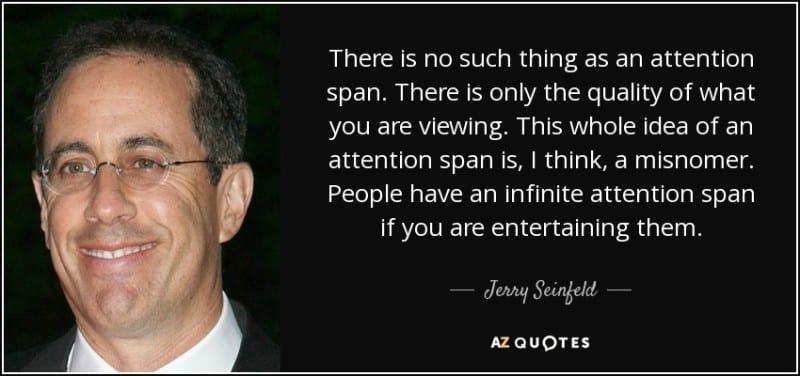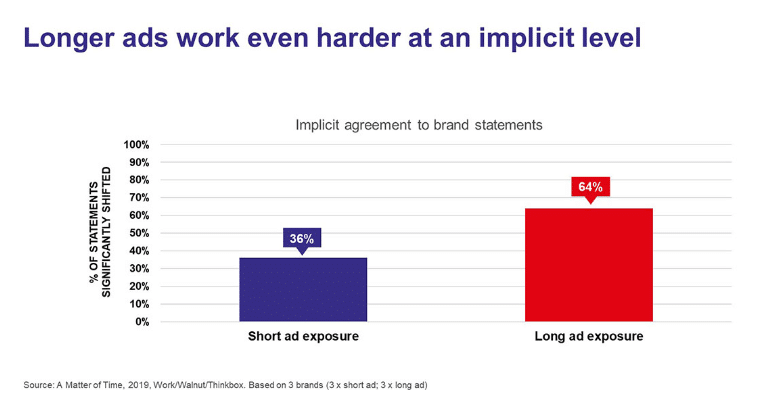
No, I’m not talking about age.
I’m talking about ad length: 60-seconds vs. 30-seconds.
When TV started, 60-second ads were the rule, rather than the exception. But in the early 70s, the loss of cigarette advertising and pressure for higher revenue forced a switch to 30-second spots as the standard.
And since 30-second spots usually sell for about 70% of 60-second spots, that makes sense — for the networks and stations!
But note that no one switched to 30s because they were more effective than 60s.
In fact, quite the opposite was true for anyone who bothered to measure it.
Just ask David Ogilvy — he’ll tell you in the first 90-seconds of this video:
Yes, Longer Ads Also Work Better for Branding
But… you might be thinking, “Ogilvy was talking about Direct Response Ads, not branding ads. Maybe branding ads work better as 30s…”
Nope. In fact, relatively recent studies show that ads aimed at creating implicit associative beliefs work better in longer formats:

Of course, there’s no shortage of online video metrics that’ll show that SHORTER videos — on the order of 15-seconds or under — are the way to go.
And here’s the thing: I’m all for telling a compelling story via short-form narrative structure.
Here’s a perfect example of that:
But most of the time, shorter ads don’t mean compelling short-form storytelling. Most of the time, shorter ads end up looking something like this:
And this gets back to the quote in the hero image for this post:
“People have an infinite attention span if you are entertaining them.”
Infinite may be a colorful exaggeration, but certainly 60-seconds is perfectly doable.
And since we know that longer ads work better at the implicit level — which is where associations are born — that makes longer ads a much better bet than shorter ads.
Throw in the fact that 60-second ads are rarely twice as expensive as 30-second ads, and you’ve got two strong reasons to opt for long-format over standard format.
What Job Do Your Ads Need to Do?
This is not to say that shorter ads don’t have their appeal.
In the Wizard of Ads world, we like to say that the job of branding is to:
“Make people think of you first and feel the best about you when they need what you sell.”
And I like to say that those are two different jobs:
- Make people think of you first (when they need what you sell), and
- Make people feel the best about you
Short-form ads can be perfect when you’re only looking to accomplish job number one.
You can pound home familiarity and reflexive recall with short-form messaging like “15 minutes could save your 15% or more on your car insurance with Geico.”
But you can’t build liking and trust — the implicit “stuff” — with short-form ads nearly as well as with longer-form storytelling. Especially when you’re telling your story.
So if you need ads to accomplish the job of “making people feel the best about you” then you’ll want to opt for longer ads — 60s over 30s (or 15-second or shorter ads).
This is why emotionally laden Christmas ads or Super Bowl ads usually run well past 60-second and into the several-minute mark.
Of course, you can always combine a schedule of longer-form and shorter-form ads to stretch a budget, but if you’re not budget constrained, it’s best to just opt for straight 60s when they’re available.
Are You Running the Right Length Ads?
A lot of professional advertisers will opt for the standard 30-second spot length.
But just because 30-seconds is the standard length doesn’t make it the right length for your branding campaign.
So if you’re wondering why your ads feel shallow, or aren’t generating the results you were hoping for, it might be because they’re not the right length.
Or because you don’t have the right ad team writing and producing them.
- Getting a Foot in the Door — Of Perception - November 27, 2025
- What Digital Superstars Know About Offline Advertising - November 17, 2025
- Unmistakable: A Tale of Two Boots and Branding Done Right - November 8, 2025
